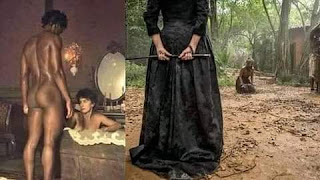The R@pe Of Women On An Epic, Historic Scale
Partition Of India And Pakistan: The R@pe Of Women On An Epic, Historic Scale
Refugees during the partition of India in 1947. CREATIVE COMMON
The partition of British India in August 1947 not only created two new independent nations, India and Pakistan, but also resulted in one of the greatest forced migrations in human history. At least 12.5 million frightened people, displaced from their ancestral homes, fled across newly delineated borders depending upon their faiths. Hindus and Sikhs exited from lands demarcated as “Muslim” Pakistan into the “new” India, while Muslims departed Hindu-dominated India into the new state called Pakistan (West and East).
Amid the massive confusion and panic, up to 1 million people (perhaps many more) died; while untold numbers of women suffered a fate worse than death -- they were raped, sometimes tortured, gang-raped and murdered. Indeed, the Partition of India and Pakistan, a decision made by lawmakers far from the front-lines, unleashed an episode of brutal depravity that might be unmatched in recent history.
These atrocities primarily occurred in Punjab and Bengal and involved venal criminality on the part of all parties concerned: Hindus, Muslims and Sikhs.
Women of all ages, ethnic groups and social classes were victimized, tortured and raped -- some even were stripped naked and paraded down streets to intensify their trauma and humiliation. In many even more tragic cases, fathers, fearing that their daughters would soon be raped (and converted to another faith), pressured and coerced the girls to commit suicide lest such an event “taint” their family's “honor” and standing in the community -- or they killed their own female relatives themselves.
Stories (some unconfirmed, others proven) abound of husbands, brothers, nephews and sons killing their female relatives to spare them the shame of rape and forced conversion. But some women voluntarily killed themselves (as well as their female children in some cases), often by self-immolation or by throwing themselves into wells. Even women who survived these atrocities could not live with their dark realities and committed suicide.
Aside from the sheer horror of sexual violation, some rape survivors had to literally wear physical signs of their shame -- rapists frequently mutilated and disfigured the girls' skins with markings and graffiti that reflected the violators’ political or religious affinities, including tattooed phrases like “Pakistan Zindabad” (Long Live Pakistan”) or “Jai Hind” (“Long Live India”) or symbols like the Hindu trident or Islamic crescent moon.
Many women had their breasts chopped off, others suffered the abuse and torture of their genitals -- in most cases leading to death. The Indian government now estimates that 83,000 women and girls were abducted and raped during Partition, but other believed this estimate is far too conservative.
Once a girl was raped, she lost her value and place in society -- she was unwanted even by her own family. In many cases, rape victims married their rapists, converted into their religion and never saw their natal families ever again.
Urvashi Butalia, an Indian feminist and author, told the Indian Express that some of these women were sold into prostitution. “Some were sold from hand to hand,” she said. “Some were taken as wives and married by conversion. And some just disappeared.''
The trauma of this violence has impacted at least three generations since 1947, as some survivors are now elderly women and only beginning to reflect on the brutality they endured. “Much of this has involved unearthing hidden histories and bringing women’s accounts into the mainstream of understanding partition,” Pippa Virdee, a professor of South Asian studies at DeMontfort University in Britain told the Women Under Siege blog.
Butalia told the tragic story of a Partition survivor named Prakashvanti, whom she met at the Gandhi Vanita Ashram in Jalandhar in Punjab, India.
In August 1947, Prakashvanti was a 20-year-old Hindu wife and mother living in the village of Sheikupura (which is now in Pakistan, close to the Indian border). As Muslim hordes approached their home, her husband implored her to kill herself in order to prevent her rape and defilement. When she refused, he threatened to kill her himself. He hit her and she fell unconscious. Thinking she was dead, her husband departed and the Muslim attackers who arrived left her alone also thinking she was dead.
IBT Fast Start - Let the best of International News come to you
Sign up and stay up to date with our daily newsletter.
When she woke, she found both her husband and child were dead. Devastated, Prakashvanti moved to an ashram, where she spent the rest of her life.
Sunny Hundal, a Sikh columnist, wrote in Britain’s Guardian newspaper that womens’ bodies become highly coveted and treasured symbols of political and familial power in India and Pakistan. “In patriarchal and feudal societies, women are almost always seen as the bearers of culture and ‘honor,’" he wrote. “Traditional, conservative South Asian culture fetishizes women to such an extent that, while the official line says they are held in high esteem and regard, in actual fact, they are treated simply as vessels of that honor, and their lives are forced to be structured around preserving that. They are not allowed to do anything that compromises those ideals, while men have much freer [rein] without the same burden.”
These deeply ingrained attitudes manifested themselves in the worst forms of violence during Partition. “When Muslim, Hindu and Sikh men wanted to take revenge for their peers being killed by the other, they deliberately went out searching for women of other religions to rape and kidnap,” Hundal added. “When villages were confronted with angry baying mobs, the women were told to commit suicide by jumping in the well for their own benefit rather than fall in the clutches of the other … It intensified bigotry on all sides, and this was frequently expressed in a battle by besmirching women's honor.”



Comments
Post a Comment